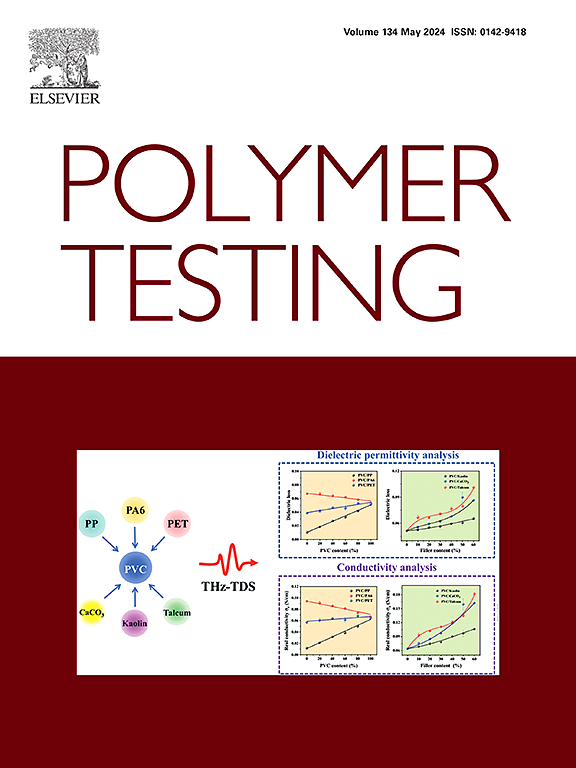Integrated thermal conductive and charring effects of hexagonal boron nitride and polycarbosilane on flame retardancy of polyolefin/magnesium hydroxide composites
IF 5
2区 材料科学
Q1 MATERIALS SCIENCE, CHARACTERIZATION & TESTING
引用次数: 0
Abstract
Halogen-free flame retardant polyolefin composites coupled with thermal conductivity are highly required to meet the challenges from thermal management and fire safety of wires and cables. The flame retardancy and thermal conductivity of polyolefin/magnesium hydroxide (PO/MH) composites were modulated by boron nitride (BN) and polycarbosilane (PCS). The synergistic effect between BN and PCS in PO/MH was demonstrated by the limiting oxygen index (LOI) of 42.9 % and the thermal conductivity of 0.66 W/(m·K). The results of cone calorimeter (CONE) evidenced the superior combustion behaviors with the reduced peak heat release rate (pHRR), total heat release (THR) and total smoke production (TSP) by 25 %, 28 % and 11 % in comparison with PO/MH, respectively. The thermal degradation by thermogravimetric analysis (TGA) revealed that PO/MH/PCS/BN took advantage of BN in stabilizing the side chain degradation and PCS in decreasing the main chain degradation rate to make for the enhanced char. And the results of X-ray diffraction (XRD), scanning electron microscopy (SEM) and X-ray photoelectron spectroscopy (XPS) illustrated the structured char that was composed of the integrated surface char acting as a barrier to mass transfer and the foamed bulk char as a barrier to heat transfer. The proposed strategy would be prospective in developing polyolefin composites integrated with thermal conductivity and flame-retardant properties for wires and cables.
六方氮化硼和聚碳硅烷对聚烯烃/氢氧化镁复合材料阻燃性能的综合导热和炭化作用
为了应对电线电缆热管理和防火安全方面的挑战,无卤阻燃聚烯烃复合材料必须具有良好的导热性。氮化硼(BN)和聚碳酸酯(PCS)调节了聚烯烃/氢氧化镁(PO/MH)复合材料的阻燃性和导热性。氮化硼和聚碳硅烷在 PO/MH 中的协同效应表现为:极限氧指数(LOI)为 42.9%,导热系数为 0.66 W/(m-K)。锥形量热仪(CONE)的结果表明,与 PO/MH 相比,燃烧性能更优越,峰值放热率(pHRR)、总放热率(THR)和总产烟量(TSP)分别降低了 25%、28% 和 11%。热重分析(TGA)的热降解结果表明,PO/MH/PCS/BN 利用了 BN 在稳定侧链降解和 PCS 在降低主链降解率方面的优势,从而增强了炭的性能。X 射线衍射 (XRD)、扫描电子显微镜 (SEM) 和 X 射线光电子能谱 (XPS) 的结果表明,结构化炭是由作为传质屏障的集成表面炭和作为传热屏障的发泡块体炭组成的。所提出的策略对于开发具有导热性和阻燃性能的聚烯烃复合材料电线电缆很有前景。
本文章由计算机程序翻译,如有差异,请以英文原文为准。
求助全文
约1分钟内获得全文
求助全文
来源期刊

Polymer Testing
工程技术-材料科学:表征与测试
CiteScore
10.70
自引率
5.90%
发文量
328
审稿时长
44 days
期刊介绍:
Polymer Testing focuses on the testing, analysis and characterization of polymer materials, including both synthetic and natural or biobased polymers. Novel testing methods and the testing of novel polymeric materials in bulk, solution and dispersion is covered. In addition, we welcome the submission of the testing of polymeric materials for a wide range of applications and industrial products as well as nanoscale characterization.
The scope includes but is not limited to the following main topics:
Novel testing methods and Chemical analysis
• mechanical, thermal, electrical, chemical, imaging, spectroscopy, scattering and rheology
Physical properties and behaviour of novel polymer systems
• nanoscale properties, morphology, transport properties
Degradation and recycling of polymeric materials when combined with novel testing or characterization methods
• degradation, biodegradation, ageing and fire retardancy
Modelling and Simulation work will be only considered when it is linked to new or previously published experimental results.
 求助内容:
求助内容: 应助结果提醒方式:
应助结果提醒方式:


